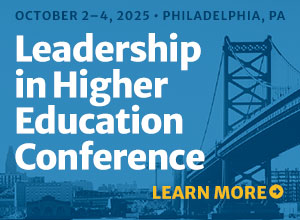Meeting Management: Strategies for Academic Leaders
For directors, chairs, deans, provosts, and even presidents, much of their visible leadership occurs through meetings. Whether face to face, virtual, or hybrid, meetings are where information is shared, decisions made, and direction created and reinforced. Effective meeting management is a tangible indicator of successful leadership. Conversely, leaders who do...
Making Faculty Governance Work: Seven Strategies for Faculty Senates
A prominent hallmark of higher education that differentiates it from other agencies and corporations is its commitment to shared governance. Shared governance can take many forms and involve students and staff, but at its center it focuses on collaboration with faculty. Faculty involvement in governance is critical to the current...
Managing by Meeting
Academics manage by meetings. Half of the day in the life of a department chair is spent in formal meetings (average length: 50 minutes), and another 22 percent in informal meetings. Thus, department chairs find themselves in meetings 70 percent of their day. For deans, the number of meetings exponentially...
The Faculty’s Role in Closing Equity Gaps: Academic Policies and Practices
Since the spring of 2020, predominantly White institutions (PWIs) of higher education have felt understandable pressure to examine everything we do through an equity lens. Colleges and universities have, for example, turned a spotlight on admissions practices that have disproportionately benefited upper-middle class students. We have also begun to rethink financial aid...
Emotionally Intelligent Leadership That Empowers, Moves Culture, and Creates Engagement
The core of these beautifully powerful and elegantly simple concepts on the neuroscience behind emotionally intelligent leadership is the happy wedding of over 40 years of teaching and leading experience with the current research on motivation, learning, and empowerment. My leadership roles as a teaching professor, head college basketball coach,...
Double Deaning: Reflections in a Mirror
Nearly everyone finds twins interesting. That is so, in part, because twins are relatively rare, with only three or four out of 1,000 births producing twins and only about 25 percent of those being monozygotic—the technical term for “identical twins.” Even more rare are those identical twins who are known...
Student Engagement: The Key to Retention
As Steven C. Howey (2012) pointed out years ago, educators across the US are “frustrated with the challenge of how to motivate the ever increasing number of freshmen students entering college who are psychologically, socially, and academically unprepared for the demands of college life.” For the past 40-plus years, the...
Partnering with Student Organizations to Build First-Year Student Engagement: Special Olympics Young Athletes and Merrimack College
Every day, academic leaders make decisions about what kinds of programming college first-year students will find attractive and engaging. Many colleges’ ideas, however, fail to connect to student interest and experience. Part of the reason for this disconnect is generational. The staff and administrators planning these programs are at least...
Celebrating Memories on Social Media to Engage Alumni
Take a moment to think back to the most vivid memories from your college experience. Do it right now: close your eyes and see what comes to mind. OK, what did you see? Maybe it was a high-profile sports game you went to, a graduation ceremony, a girlfriend or boyfriend...
Leadership Development: One College’s Solution
A recent Inside Higher Ed article discussed the need for leadership training for faculty and academic staff as a way to prepare them for higher education’s ongoing challenges, such as competition for students, equity issues, and financial pressures (Cano & Whitfield, 2019). As faculty members in the Touro College and University...












